This Paris-made pan began its career on trains in Spain and Portugal.
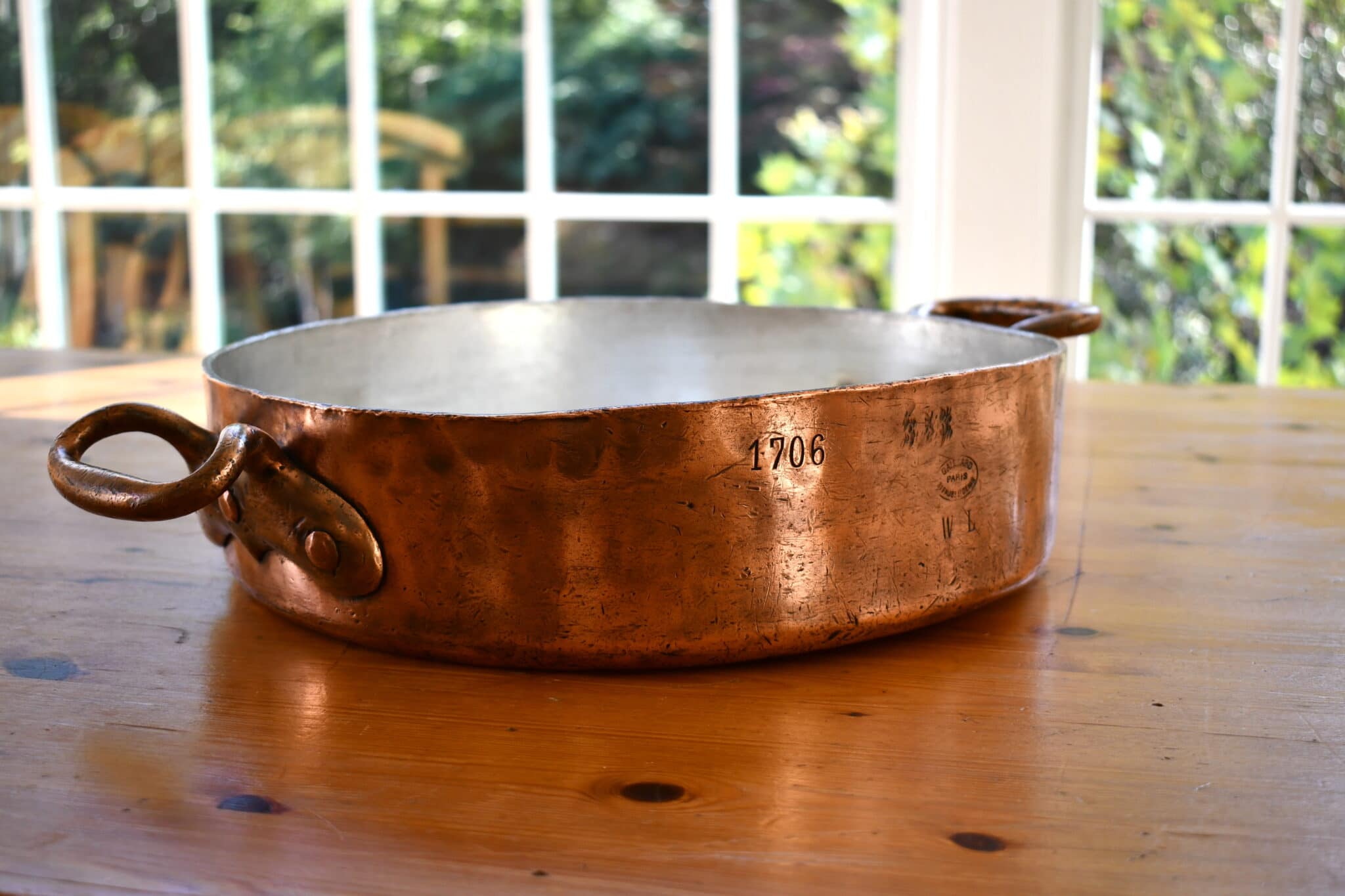
| Type | Tin-lined rondeau in hammered finish with brass handles attached with three copper rivets |
| French description | Rondeau étamé et martelé avec poignées en laiton munies de trois rivets en cuivre |
| Dimensions | 36cm diameter by 10cm tall (14.2 by 3.9 inches) |
| Thickness | 4.2mm at rim |
| Weight | 7766g (17.1 lbs) |
| Stampings | GAILLARD 81 FAUBG ST DENIS PARIS; WL; 353 (effaced); 1706 |
| Maker and age estimate | Gaillard; 1890s |
| Source | Normandy Kitchen Copper |
Longtime readers of this site know that I have a fondness for railway copper and in particular for pieces carrying the WL stamp of Compagnie International des Wagons-Lits, or CIWL, the great railway operator in Europe. There is something ineffably romantic to me about the vision of an overnight express hurtling across a cool dark landscape, windows warm with light, the creak of the train and the rattle of the tracks harmonizing with the conversation of travelers gathered in the dining car to enjoy an evening meal before retiring to a snug cabin. Of course, this pan must have somewhat different memories of hard work in the galley kitchen surrounded by the shouts of the harried staff and the crash and bang of busy cooking!
And crashed and banged this pan certainly was. One of its handles has been bent and very nearly snapped off.
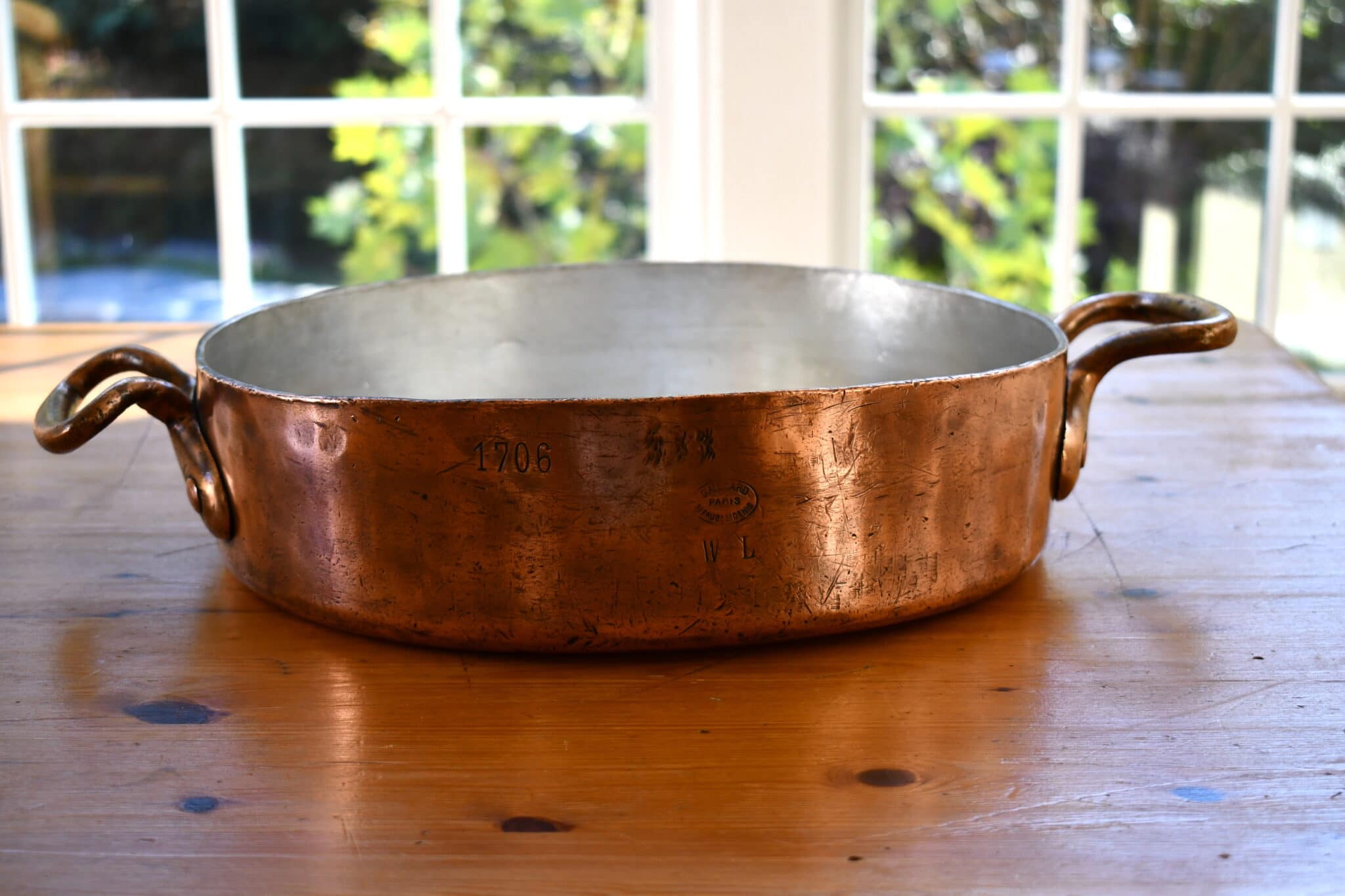
One prong was cracked and repaired with what looks to be copper. Val Maguire at Southwest Hand Tinning did the restoration work on this piece and she noted that it’s somewhat unusual to use copper for a handle repair. Copper is relatively pliable and this repair won’t contribute much rigidity to the cracked section — it’s not fusing the cracked pieces together so much as wrapping them like a bandage. Why was the handle not repaired properly with brass or silver solder, or better yet, replaced altogether?
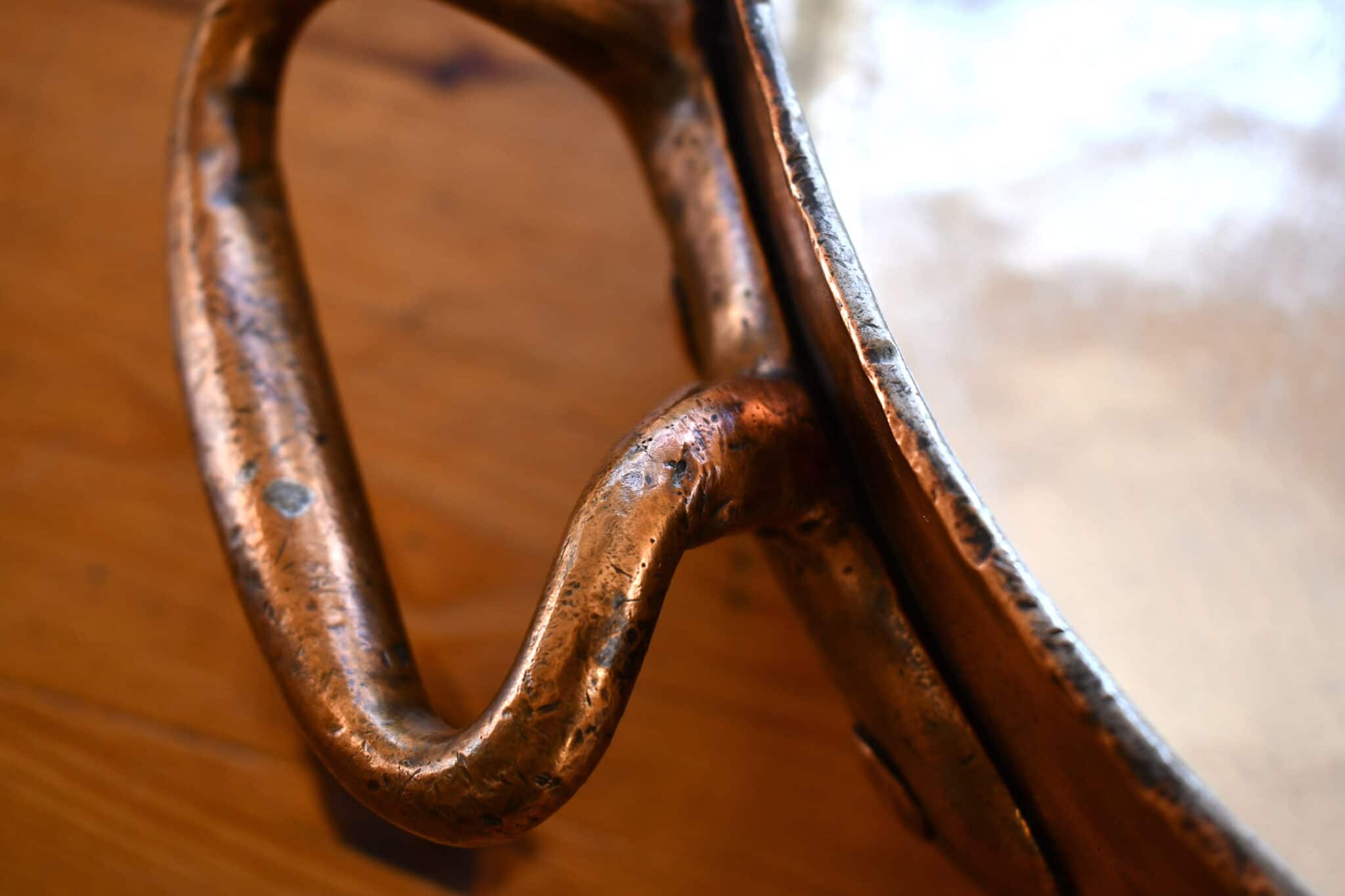
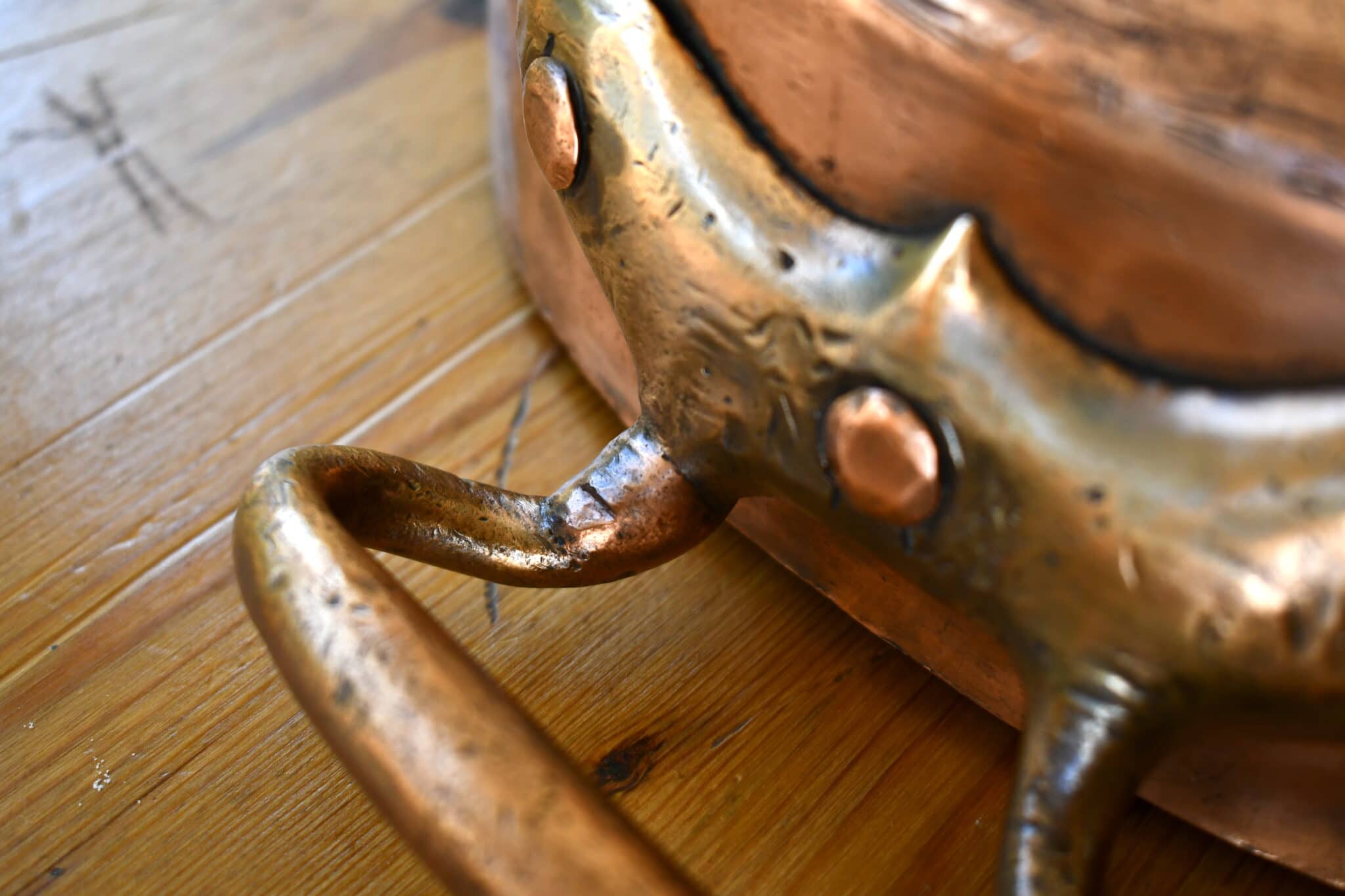
The handle was taken off for the repair and reattached, leaving the pan with both original and replacement rivets. Here are the two handles side by side so that you can see the difference. It’s pretty obvious which one has had some work on it. The repaired handle is on the right, and I see lots of hammer marks in the brass around the rivet area. Whoever did this repair did not have the same tools or experience as the Gaillard smith who made this pan.
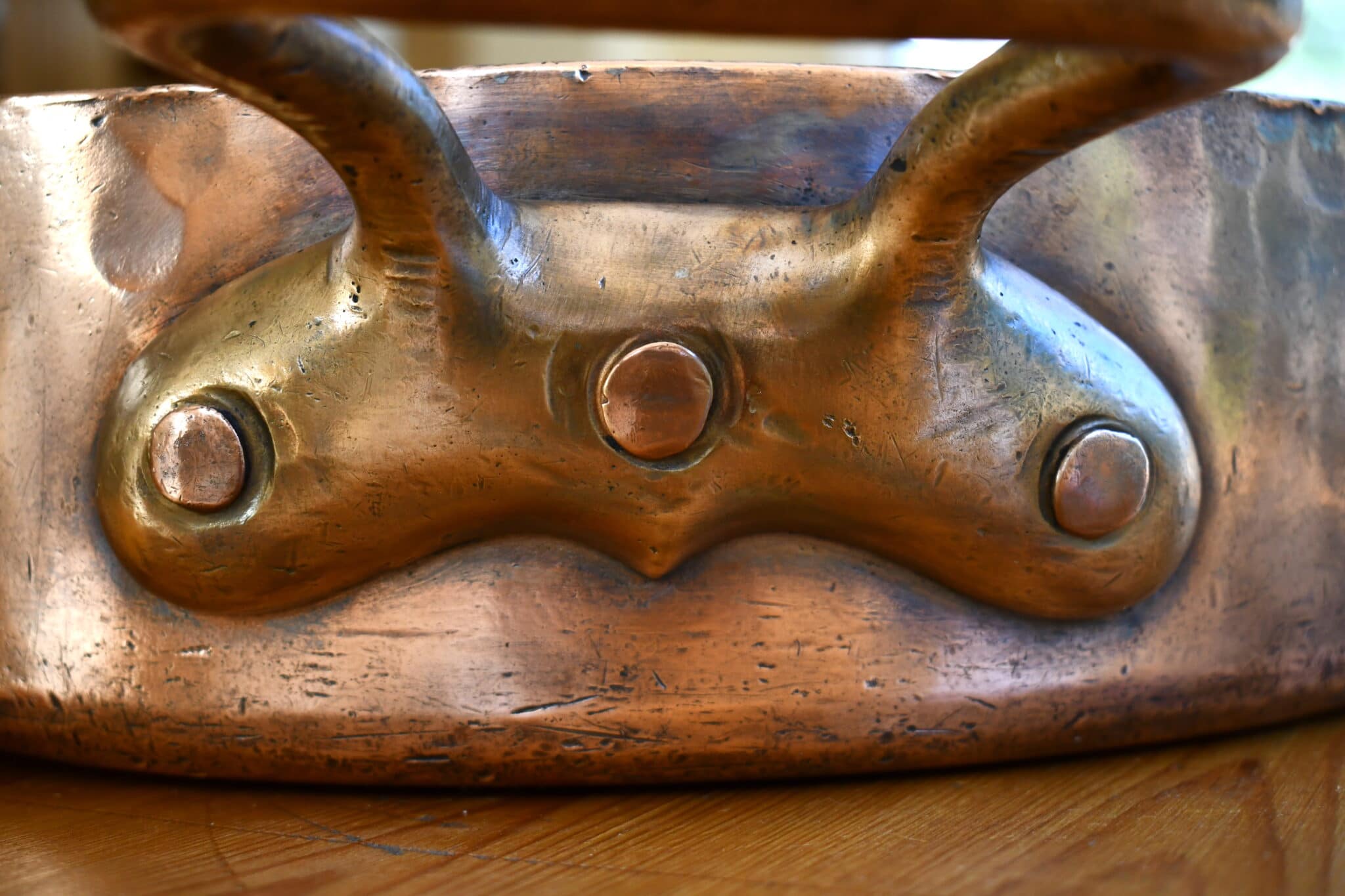
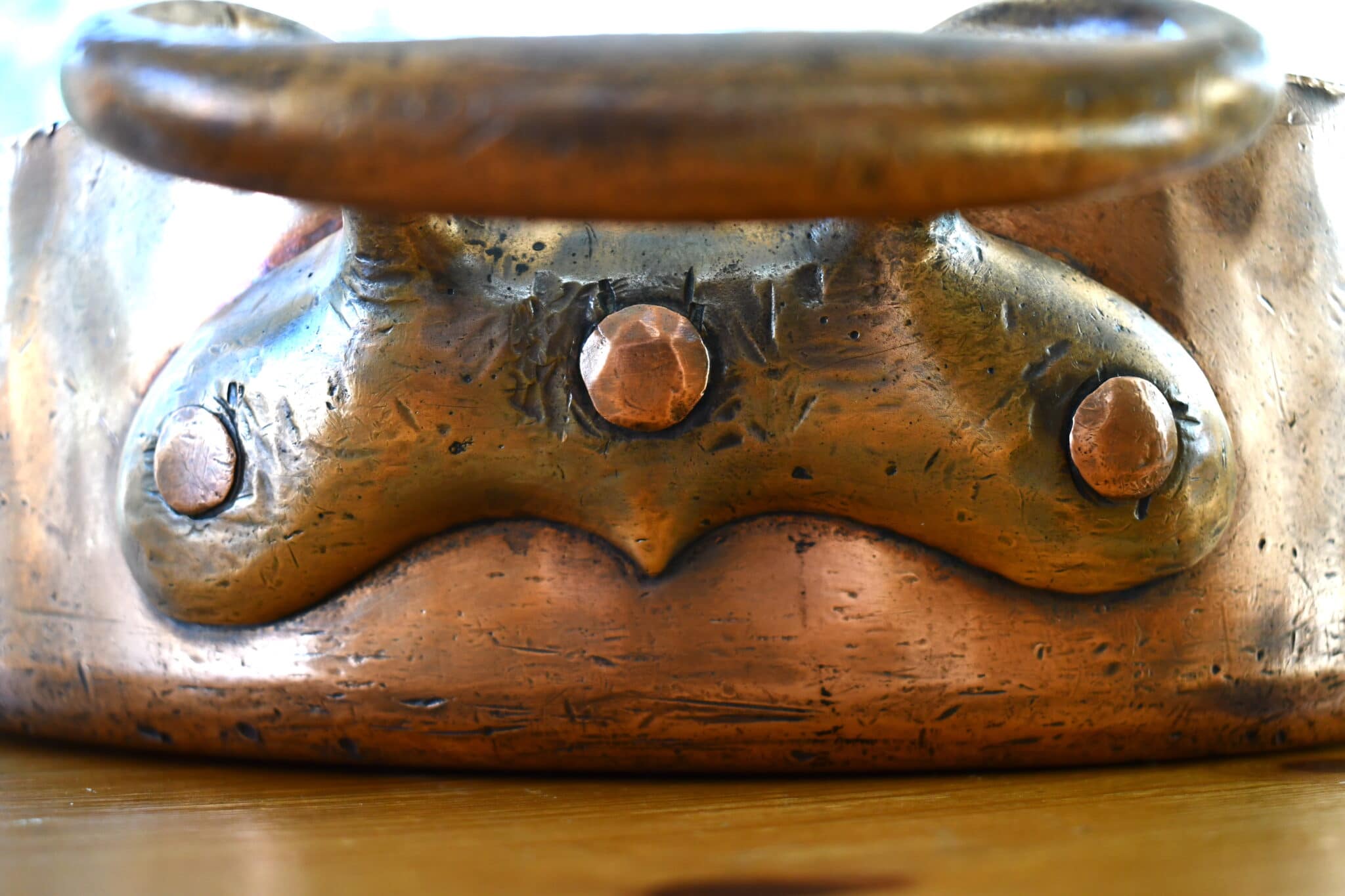
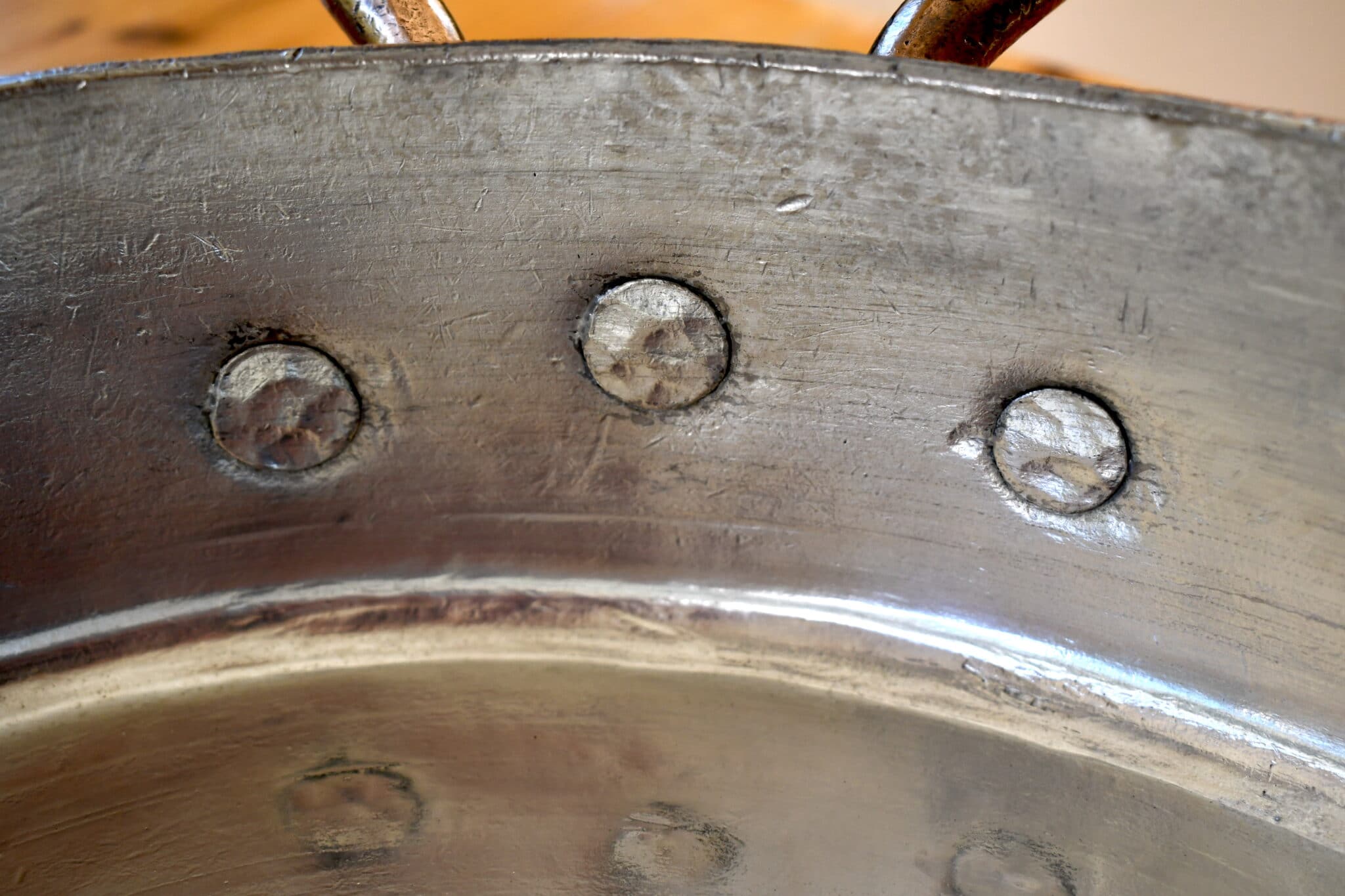

The interior rivet heads are set almost flush to the surface while the replacement rivets are slightly more protuberant. Both handles have been tightened — you can see indentations on the interior heads where a smith used a hammer to try to spread the rivet within its hole. The original rivets are flat and nearly flush-set in keeping with other Gaillard pieces of this era, but the replacement rivets appear to have a mushroom head.
The same kind of rough handling that damaged the handle has also given the pan a wonky geometry. It seems to have been torqued, as though a very strong person held the pan in two hands and twisted it. One side of the pan lifts a few millimeters off the surface of the table; turned over, the height variance in the rim creates a gap that you can see in the photo below.
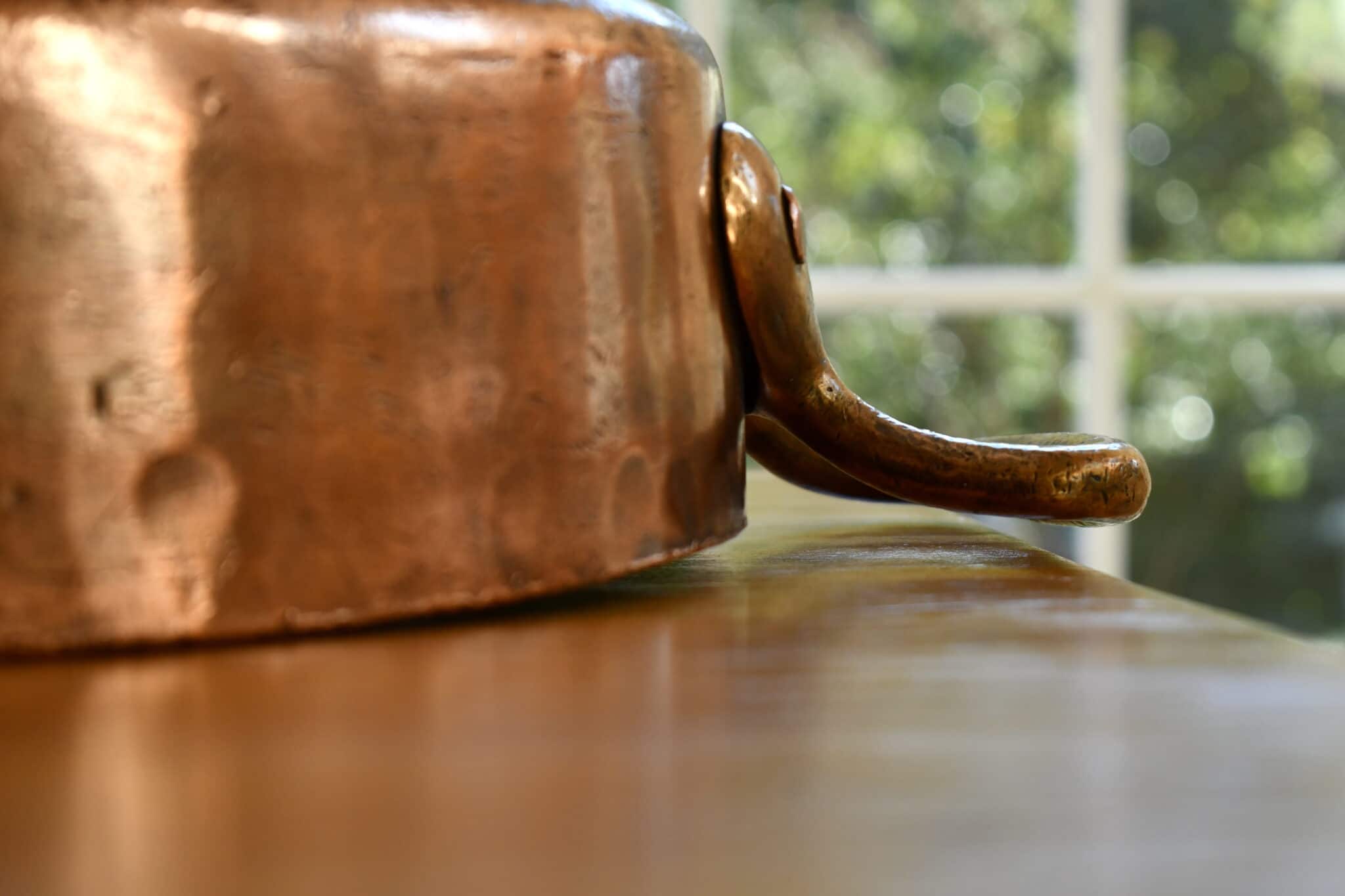
It must have taken some impressive force to do this. This is a true 4mm-plus rondeau — I measured the rim at 4.2mm, and up to 4.5mm in spots — and it weighs 7766g unladen (just over 17 pounds). Despite this twist in the pan, Val Maguire was able to get the pan to sit steady. The base of the pan is concave but Val brought the edges of the base down to make enough contact to stabilize it.
This means that the floor of the pan is very slightly domed. In my experience, many antique pieces of this scale don’t have absolutely flat floors, whether as a consequence of their manufacture or the result of a century or so of use. (I have a theory that this is actually intentional: could a slight arch across the floor of the pan better support a heavy load without collapsing?) A domed base can be a challenge for cooking surfaces that rely on direct contact, such as electric coils or radiant heat; if that is your cooktop and you are shopping for a large-diameter piece, look for recent-era copper that is more likely to have a perfectly flat base, or make sure before you buy that the pan is flat enough for your cooktop.
I am fortunate that I have a gas stovetop that isn’t inhibited by the distance between the flame and the base of the pan. That said, it’s good to remember that liquids will run downhill to the lowest point on the floor of any pan. This is not a big deal for cooking stews or sauced dishes but can be inconvenient for sautéing, as an uneven or domed base can develop dry spots. I haven’t cooked in this rondeau yet but I put a little water in it to see how a liquid would flow. I was pleasantly surprised that the water didn’t immediately flee from the center, suggesting that the curvature isn’t significant.
The pan has a maker stamp reading “GAILLARD 81 FAUBG ST DENIS PARIS” within an oval cartouche, and I estimate it was made sometime between 1890 and 1904 or so. I know it is a CIWL piece because of the “WL” stamp for Wagons-Lits. And as is sometimes the case with WL pieces there are also two sets of numbers: “353” almost obliterated, and a much more clear “1706.” My theory is that these numbers correspond to their assigned trains on the CIWL line, but as many CIWL cars have been lost, it’s been difficult to research this.
I reached out to the model train forums at LR PRESSE for help researching these numbers and I am very pleased to report that they were able to help connect this pan to two specific CIWL restaurant cars.
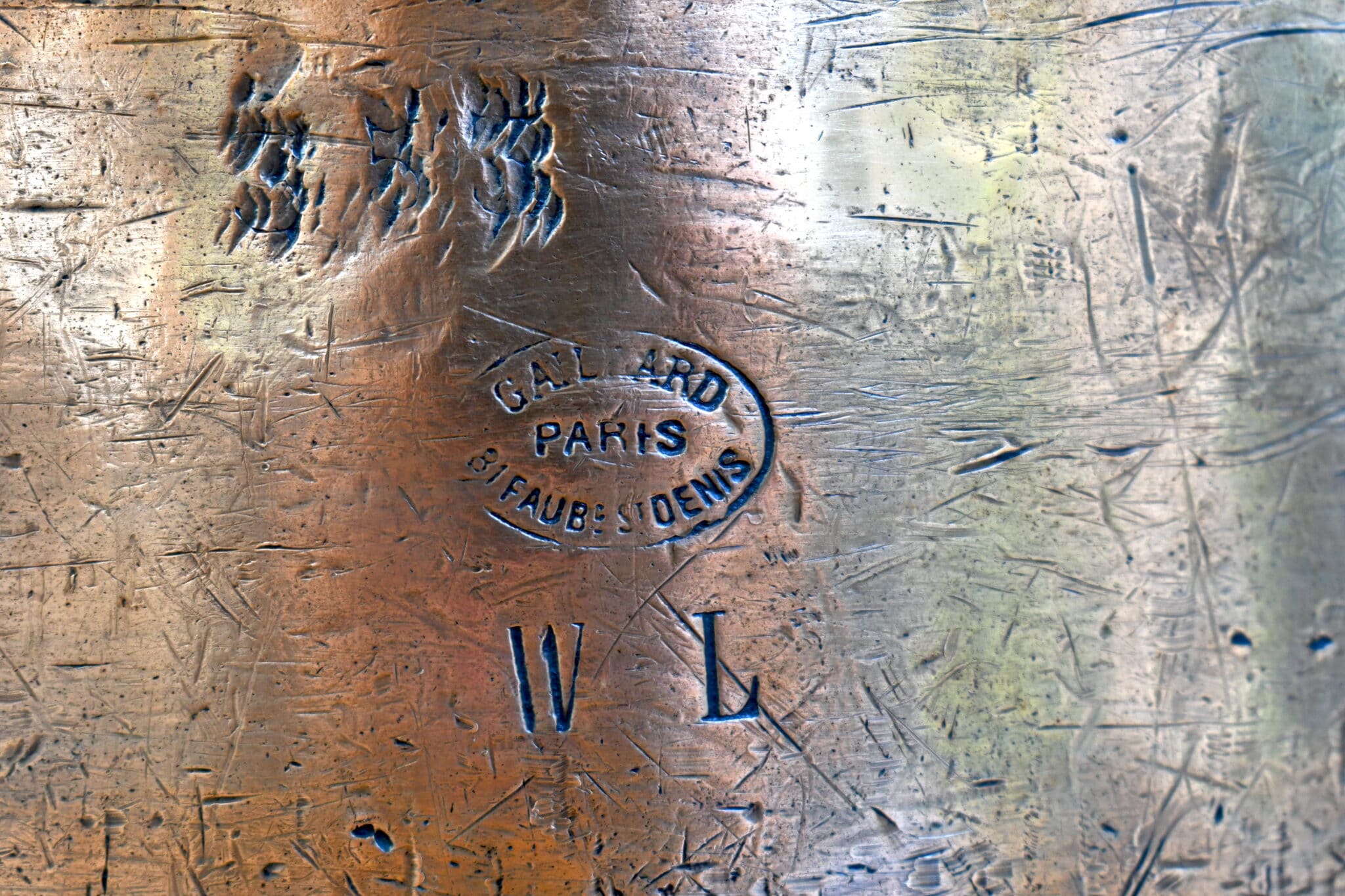
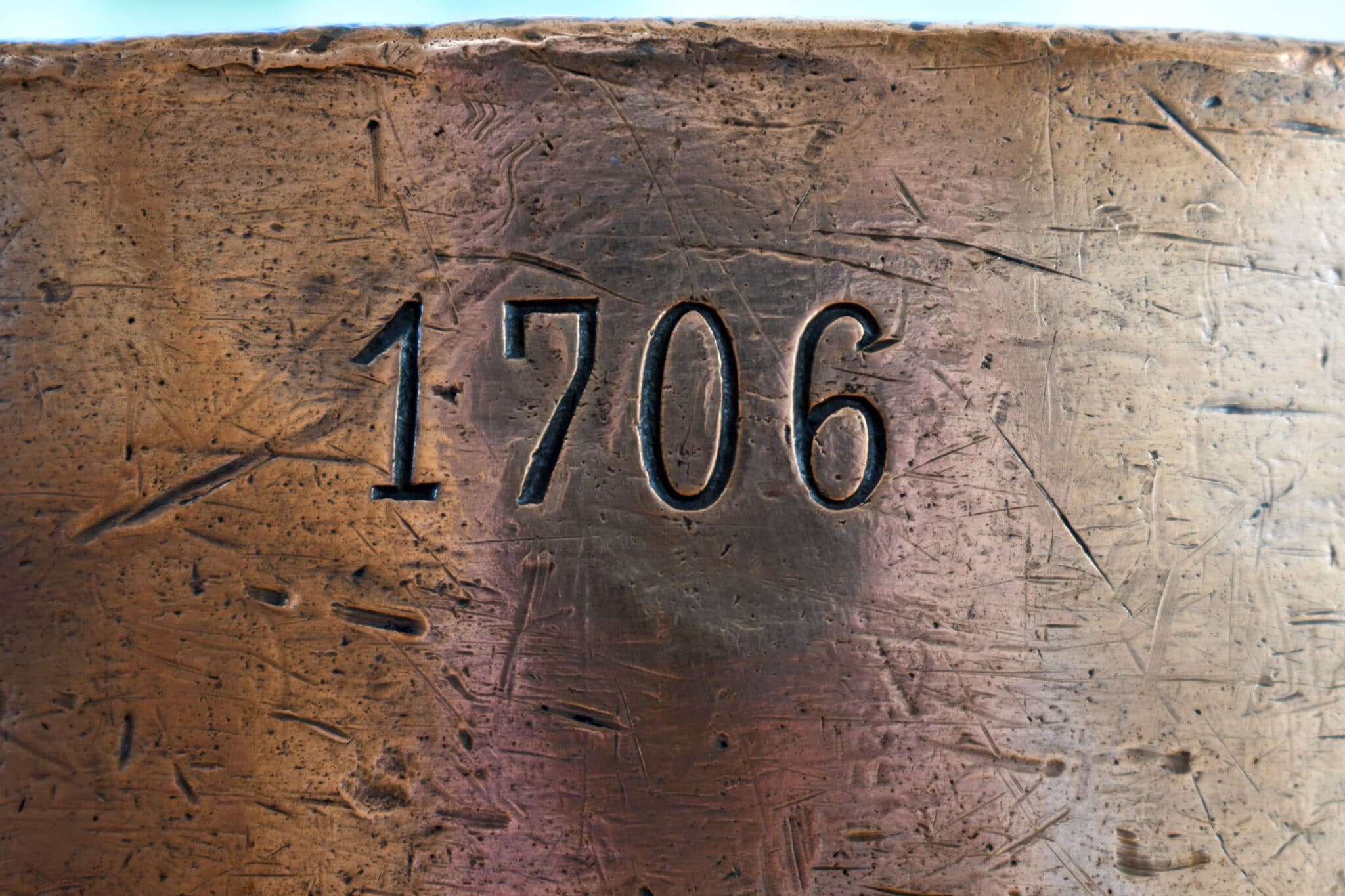
According to these numbers, this pan was initially assigned to wagon-restaurant (WR) 353 built in 1891 in CIWL’s railyard in the Basque town of Irun for their Iberian fleet. LR PRESSE forum member Pierre explained to me that the track gauge in Spain and Portugal was wider than in the rest of Europe and so CIWL maintained a separate fleet of engines and carriages for these routes. (According to Pierre, it was not until the 1960s that the technology was invented for trains to change gauge at the border.) By incredible good fortune, the design of WR 353 is featured in the book Coches Camas Restaurantes Y Salones En Los Ferrocarriles De La Peninsula Iberica by Javier Aranguren (1996), and by another stroke of luck, forum reader Fred has a copy of this out-of-print book and was kind enough to share the diagrams below.


Look at that tiny kitchen! Imagine this 36cm rondeau sitting atop that stovetop. No wonder this pan is so thick — it had to turn a small burner into a thousand square centimeters of cooking space.
The second stamp corresponds to WR 1706, a CIWL car built in 1906 also for the Spanish and Portuguese routes. This car was built by Ringhoffer, a mechanical engineering and coachbuilding company founded in 1854 in Prague. I’m still trying to track down a photo of this exact dining car type, but in the meantime here’s a 1908 article about a Ringhoffer dining car of about the same era, if not the same design.

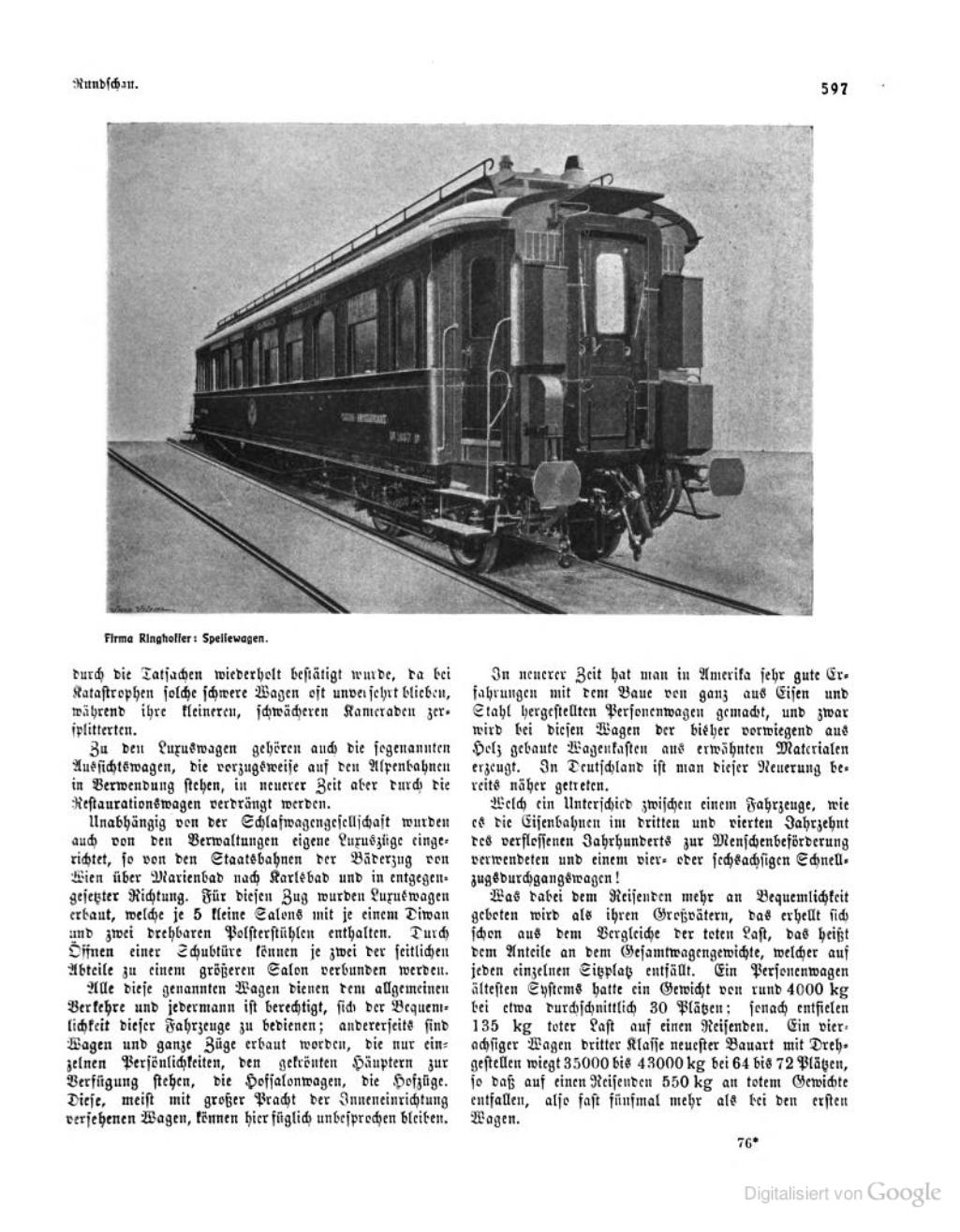
These railway car stamps are very helpful to fix copper maker stamps in chronological sequence. The Gaillard stamp on this piece is one I have theorized was in use from about 1890 to about 1904. The 353 stamp establishes that the pan was in use sometime between 1891 and 1906, which is excellent support for my theory. Of course, it would be nice to know whether this pan was part of the car’s original complement of cookware — that is, made circa 1891 — or if it was a later addition, but I am just happy that the maker stamp and restaurant car stamp align so well!
I am deeply grateful to Pierre, Fred, and the LR PRESSE forums for identifying WR 353 and WR 1706. I am just a visitor to their site but I have a certain fellow-feeling with the model train enthusiast community. Like them, I seek to preserve artifacts of an earlier century and to foster an appreciation for their design and construction. And like them, I take deep satisfaction in using dates and facts to form a vision of how these pieces were made and used. I thought that the damaged handle on this rondeau was repaired somewhat unconventionally but now that I know more of this its history I understand it in a different way. This pan was made in Paris but served its early career far from those master chaudronniers. When it was damaged — almost seriously enough to snap off its handle — it fell to a nameless smith in Spain to try to fix it. I don’t know what he thought or felt as he hefted this heavy piece in his hands, but even then a 4mm pan was a valuable thing and worth saving. His repair was not as skilled as what one would expect from the smiths in Paris but it got the pan back in service and it has kept the pan intact for more than century. Holding the pan in my hands and knowing more of its history, all I feel now is gratitude.
My thanks to Fid and Bill at Normandy Kitchen Copper for finding this piece and making it available, and to Val Maguire at Southwest Hand Tinning for the restoration.






A facinating piece of research. And a wonderful pan.
A wonderful addition to your Wagons-Lits collection! It shows its many miles through its scars and yet is still able to perform in the kitchen. A nice bonus is the detective work that revealed its early history. Congratulations VFC!
Thanks Stephen! Credit goes to the guys at LR PRESSE. They were so kind to look up the numbers for me and that was what enabled the connection to a place and time. I’m working to correct my other WL pan posts with these updates as well.
The bottom draw-in always remains a technical necessity, which does not have any disadvantages for the cook. EVERY pan that is properly constructed has a slightly concave bottom, and today it is even standardized.
Cavity due to limited space:
However, since a pan has a solid rim, the heated bottom can only expand to a limited extent. If there were no hollow vaults, the bottom would push itself in the only remaining direction when heat was introduced – namely upwards (convex).
The pan would then prance on the hob when heated. The soil indentation opposes this convex expansion. This means that the pan is safe and secure on the stove even at the highest temperature.
Types of concavity:
The floor recess can be poured both lengthways and in the middle (concentric). If it is poured lengthways, two edges lie on the left and right of the longitudinal axis on the hob and the pan appears to wobble slightly when cold. If, on the other hand, the hollow vault is poured in the middle, the pan has an undetectable cavity in the middle between its bottom and the stove surface.
The size of the cavity depends on the materials used, the height of the rim and the bottom diameter of the pan. In part, it corresponds to the regulation by DIN standard 44904, which specifies a maximum internal curvature of 6 ‰ of the bottom diameter. In most cases, however, the optimal soil penetration is less and is difficult to see with the naked eye without a fixed point.
Martin, thanks for this. I guessed that the domed base was purposeful but now I understand why it is!
Excellent research VFC, as always! I love how you placed this pan in its historical context so well, knowing the railway design that your pan worked in right down to the diagram. How neat! Also, what a pretty and sturdy pan! What a great acquisition!
Thank you Amy!
VFC, what a wonderful research! Thanks. You’d like to travel back in time and book a place for a trip.
I already knew that the kitchens in these wagons were quite small, but I have never seen such a small kitchen as on this floor plan. Now I can definitely no longer use my small kitchen as an excuse for less successful cooking.
Hi Martin! I would love to have traveled on these great trains. There are still preserved CIWL cars on special routes that you can take today.
Marvelous research VFC!
You make copper pans really come alive, VFC! Excellent research written beautifully!
Hello NKC, we collectors shouldn’t forget the “scouts” in France who “dig up” such treasures for us. Without shops like the ones you run on Ebay, these discoveries would be much more difficult to make. Thank you very much for your effort.
Martin, you are so correct. Finding these pieces is a multi-step process and I am grateful to the “pickers” who unearth them as well as the sellers who make them available on the marketplaces.
I defintely wrote to NKC (Normandy Kitchen Copper), but apparently the automatic correction replaced the abbreviation with the one (VFC) that I have been using most frequently for some time.
[VFC: Fixed!]
Thank you Martin for your comment, it really is a labour of love and great fun, I get to scour flea markets all over northern France including Paris – I am incredibly lucky to have a job that myself and Bill totally adore! We have been able through a lot of hard work and study to barely scratch the surface of the history of copper making in France, I am extremely grateful to VFC for the invaluable resource she has put together here, I refer to the incredible research here often!